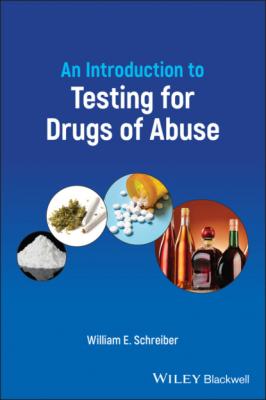An Introduction to Testing for Drugs of Abuse. William E. Schreiber
Читать онлайн.| Название | An Introduction to Testing for Drugs of Abuse |
|---|---|
| Автор произведения | William E. Schreiber |
| Жанр | Химия |
| Серия | |
| Издательство | Химия |
| Год выпуска | 0 |
| isbn | 9781119794073 |
7 Section III: Appendices Appendix A: How to Read a Toxicology Report Format Screening Tests Confirmation Tests Drugs and Their Metabolites Further Reading Appendix B: Guideline Documents: Pain Management and Addiction Medicine Pain Management Addiction Medicine Further Reading
8 Index
List of Tables
1 Chapter 1Table 1.1 Controlled substance schedules in the United States.Table 1.2 Cut‐off concentrations for drugs and metabolites in urine.
2 Chapter 3Table 3.1 Substance Abuse and Mental Health Services Administration criteri...Table 3.2 Substance Abuse and Mental Health Services Administration criteri...Table 3.3 Substance Abuse and Mental Health Services Administration criteri...
3 Chapter 6Table 6.1 Cross‐reactivity of structurally related compounds in a commercia...
4 Chapter 7Table 7.1 Cross‐reactivity of amphetamine‐type stimulants in a commercial i...Table 7.2 Drugs that can give a positive test result in an immunoassay for ...
5 Chapter 8Table 8.1 Potency, half‐life, and clinical uses of common benzodiazepines....Table 8.2 Cross‐reactivity of selected benzodiazepines in a commercial immu...Table 8.3 Dosage and half‐life of Z‐drugs.
6 Chapter 9Table 9.1 Elimination half‐life data for common barbiturates.Table 9.2 Cross‐reactivity of selected barbiturates in a commercial immunoa...
7 Chapter 10Table 10.1 Relative potency of opioids.Table 10.2 Cross‐reactivity of opioids in a commercial immunoassay.
8 Chapter 11Table 11.1 Cross‐reactivity of cannabinoids in a commercial immunoassay....
9 Chapter 12Table 12.1 Elimination half‐life data for hallucinogens.Table 12.2 Drugs that can give a false‐positive immunoassay result for phen...
10 Chapter 13Table 13.1 Signs and symptoms of alcohol intoxication.Table 13.2 Criteria for alcohol use disorder according to the Diagnostic an...Table 13.3 Specimen type and window of detection for markers of alcohol con...
11 Appendix ATable A.1 Amphetamine‐type stimulants, cocaine, and their metabolites.Table A.2 Benzodiazepines and their metabolites.Table A.3 Opioids and their metabolites.Table A.4 Alcohols, cannabis, and their metabolites.
List of Illustrations
1 Chapter 1Figure 1.1 Graph comparing harm to users (x‐axis) vs harm to others (y‐axis)...Figure 1.2 Costs of substance use in Canada in 2017. For each substance, the...
2 Chapter 2Figure 2.1 Structures of uridine diphosphate (UDP) glucuronic acid and phosp...
3 Chapter 4Figure 4.1 Radioimmunoassay (RIA). A drug labeled with a radioisotope compet...Figure 4.2 Enzyme multiplied immunoassay technique (EMIT). An enzyme attache...Figure 4.3 Cloned enzyme donor immunoassay (CEDIA). The free donor–drug comp...Figure 4.4 Kinetic interaction of microparticles in solution (KIMS). The dru...Figure 4.5 Lateral flow immunoassay. (a) A patient sample is applied to the ...
4 Chapter 5Figure 5.1 Diagram of a gas chromatograph. The carrier gas flows from the ga...Figure 5.2 Blood alcohols separated by gas chromatography. The x‐axis gives ...Figure 5.3 Prescription opioids and their metabolites separated by liquid ch...Figure 5.4 Components of a mass spectrometer. The ion source
